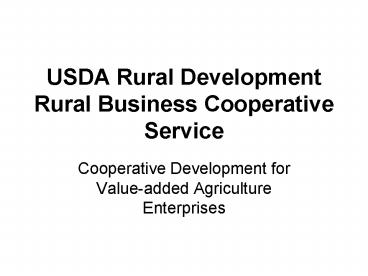USDA Rural Development Rural Business Cooperative Service - PowerPoint PPT Presentation
1 / 18
Title:
USDA Rural Development Rural Business Cooperative Service
Description:
... sells commodities outside the community taking money away ... Cooperatives stabilize communities by keeping jobs at home and making local investments ... – PowerPoint PPT presentation
Number of Views:57
Avg rating:3.0/5.0
Title: USDA Rural Development Rural Business Cooperative Service
1
USDA Rural DevelopmentRural Business Cooperative
Service
- Cooperative Development for Value-added
Agriculture Enterprises
2
Why Cooperate?
- Commodity Value Chain
- Stabilize Communities
- Cooperatives What are They?
- Cooperative Finance
- New Generation Cooperative Overview
- Steps to Starting a Co-op
3
Commodity Value Chain
- From field to pantry value is added by
processing, distributing, and retailing - From 1990-2000 Consumer Food expenditures rose
51 (211 Billion ) - From 1991 2001 retail food prices rose 27
- 92 of this increase is due to marketing costs
4
Commodity Value Chain
- US Consumers spend 10 of their disposable income
on food 2,964 / person - Per capita food costs will increase 7.1
(3,174) by 2020 - Overall Food Costs will increase 26 by 2020
5
Commodity Value Chain
- Marketing consumes .80 of the cost of Food to US
Consumers - Packaging, transporting, processing, retailing
- Farmer Gross Return is .20 of the US Food Dollar
- Farmers receive a disproportionately smaller
return when they sell unprocessed commodities - Net Return is less than .04
6
Commodity Value Chain
- Market consolidation in agriculture compounds
this problem - To earn larger profits, farmers need to control
more of the value chain - Eliminate middlemen and move closer to the market
place - Shortening the value chain requires resources
beyond the means of a single farmer
7
Stabilize Communities
- Traditional marketing sells commodities outside
the community taking money away - Cooperatives stabilize communities by keeping
jobs at home and making local investments - Cooperative marketing allows
- Farmers to process the commodities,
- Keeps profits and jobs in the community,
- Helps raise capital,
- Helps obtain technical assistance
8
Cooperatives What are They?
- A cooperative is a specialized type of
corporation. - A business owned and controlled by the people who
use its services. - Cooperative principles explain how a cooperative
operates - User Owned
- User Controlled
- User - Benefited
9
Cooperative Finance
- Owner - Equity Capital
- Direct Contributions
- Membership fee
- Purchase of Shares or Stock
- Retained Patronage (Retained earnings)
- Per Unit Assessments
- Owner - Debt Capital
- Short Term Loans
- Long Term Loans
10
New Generation Cooperative
- Equity Investment required up front
- Delivery Rights equal processing capacity
- Producer Agreements with Cooperative Link
delivery of product to Equity Units purchased - Members assume an obligation to deliver product
- Cooperative assumes the obligation to buy the
production
11
New Generation Cooperative
- Cooperative is authorized to purchase commodities
for undelivered contracts - Transferability of equity (delivery rights)
assures market price for equity shares based on
earnings potential - Cash Patronage is usually higher since equity is
achieved in advance of start up.
12
Why Do Some Co-ops Fail?
- Members join but dont support the co-op
- Members and directors dont participate
- Lack of effective cooperative education
- Low cost management most expensive
- Insufficient member investment
- Concealing facts about the co-op good or bad
- Allowing cliques and special interest groups to
thrive
13
Why Do Some Co-ops Fail?
- Producer resistance to up-front equity
- Payments too high for raw commodity and not
supported by end use market - Producer resistance to grow the required crop
variety to maximize yields price - Producer resistance to follow recommended growing
practices
14
Lessons for Success
- Provide the goods and services the members use
- Adequate financing by members-
- the greater the ownership by members the more
efficient the cooperative - Members support the cooperative and use it
- Maintain open communication with members
- Select and develop a good management team
- Aggressively positioned for changes in markets,
operations, and member needs
15
Steps to Starting a Co-op
- Complete a comprehensive, honest, feasibility
study - Select a steering committee and advisory
committee - Complete a detailed Business Plan with financial
forecasts and operating plan - Select an Interim Board of Directors
- Establish a Search Committee and hire a Chief
Executive Officer
16
Steps to Starting a Co-op
- Conduct due diligence and launch equity campaign
- Price per Share is determined by dividing equity
needed (40- 50) by the number of shares - Prospective farmer investors may be required to
have a minimum net worth - Steering Committee must believe in the project
and in the cooperative idea and be able to
communicate these to the public
17
Steps to Starting a Co-op
- May take up to two years to get the required
equity - It will take a lot of meetings
- It will have to survive negative and public
scrutiny - It may require a lot of members
- DONT RUSH TO THE END
- HIRE QUALIFIED CEO/CFO, LEGAL, and ACCOUNTING
SERVICES EARLY
18
Thank You!
- For assistance with starting a cooperative or
improving its operations contact - John Brugger
- Cooperative Development Specialist
- 8815 E. Mission, Ste B
- Spokane, WA 99212
- 509-924-7350 EXT 114
- Or E-mail john.brugger_at_wa.usda.gov































